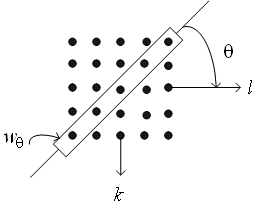Spatial Operations
Many image enhancement techniques are based on spatial operations performed on local neighbourhoods of input pixels. Often, the image is convolved with a FIR filter called "spatial mask".
Spatial averaging and spatial lowpass filtering:
Here each pixel is replaced by a weighted average of its neighbourhood pixels i.e.
 where where  and and  are i/pr opposite images. w is a suitably chosen window and are i/pr opposite images. w is a suitably chosen window and
 are the filter weights. are the filter weights.

Figure( 5.11): Spatial averaging masks  |
A common class of spatial averaging filters has all equal weights giving
 where where 
 is the number of pixels in the window.Another spatial averaging filter used often is given by is the number of pixels in the window.Another spatial averaging filter used often is given by
 ie. each pixel is replaced by its average with the average of its nearest four pixels. ie. each pixel is replaced by its average with the average of its nearest four pixels.
Uses
Spatial averaging is used for noise smoothing, LP filtering and subsampling of images. Suppose observed image is
 white noise with zero mean variance white noise with zero mean variance
=

Then spatial average yields
where  the spatial average of the spatial average of
 has zero mean and variance has zero mean and variance  . ie. noise power is reduced by a factor equal to number of pixels in window w . . ie. noise power is reduced by a factor equal to number of pixels in window w .
If the noiseless image  is constant over the window, then spatial averaging results in an improvement in output. is constant over the window, then spatial averaging results in an improvement in output.
SNR by a factor of 
In practice the size of window w is limited due to the fact that  is not really constant, so that spatial averaging introduces a distortion in the form of blurring. is not really constant, so that spatial averaging introduces a distortion in the form of blurring.
Directional smoothing

Figure( 5.12):Directional smoothing filter |
To protect edges from blurring while smoothing, a directional averaging filter is used. Spatial average  are calculated in several directions as are calculated in several directions as

And a direction  is found such that is found such that
 is minimum is minimum
Then  gives the desired result. gives the desired result. |